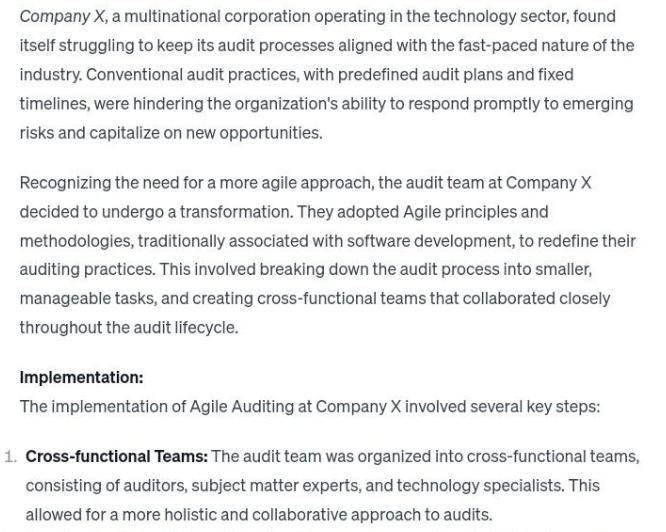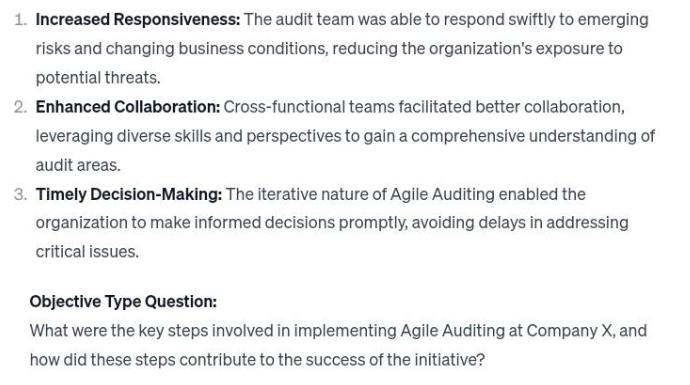Answered step by step
Verified Expert Solution
Question
1 Approved Answer
Company X, a multinational corporation operating in the technology sector, found itself struggling to keep its audit processes aligned with the fast-paced nature of



Company X, a multinational corporation operating in the technology sector, found itself struggling to keep its audit processes aligned with the fast-paced nature of the industry. Conventional audit practices, with predefined audit plans and fixed timelines, were hindering the organization's ability to respond promptly to emerging risks and capitalize on new opportunities. Recognizing the need for a more agile approach, the audit team at Company X decided to undergo a transformation. They adopted Agile principles and methodologies, traditionally associated with software development, to redefine their auditing practices. This involved breaking down the audit process into smaller, manageable tasks, and creating cross-functional teams that collaborated closely throughout the audit lifecycle. Implementation: The implementation of Agile Auditing at Company X involved several key steps: 1. Cross-functional Teams: The audit team was organized into cross-functional teams, consisting of auditors, subject matter experts, and technology specialists. This allowed for a more holistic and collaborative approach to audits. 2. Iterative Auditing: The traditional audit process was replaced with iterative cycles. Instead of waiting until the end of an audit to present findings, the team conducted regular reviews and assessments, allowing for continuous improvement and adaptation. 3. Flexible Planning: Agile Auditing embraced the principle of flexible planning. Rather than sticking rigidly to predefined audit plans, the team adjusted their focus based on emerging risks and changing business priorities. 4. Constant Communication: Regular communication and feedback sessions were instituted to ensure that all team members were aligned and responsive to real-time changes in the business environment. Results: The adoption of Agile Auditing brought about significant positive outcomes for Company X: 1. Increased Responsiveness: The audit team was able to respond swiftly to emerging risks and changing business conditions, reducing the organization's exposure to potential threats. 2. Enhanced Collaboration: Cross-functional teams facilitated better collaboration, leveraging diverse skills and perspectives to gain a comprehensive understanding of audit areas. 3. Timely Decision-Making: The iterative nature of Agile Auditing enabled the organization to make informed decisions promptly, avoiding delays in addressing critical issues. Objective Type Question: What were the key steps involved in implementing Agile Auditing at Company X, and how did these steps contribute to the success of the initiative?
Step by Step Solution
There are 3 Steps involved in it
Step: 1
The key steps involved in implementing Agile Auditing at Company X were Crossfunctional Teams The audit team was organized into crossfunctional teams ...
Get Instant Access to Expert-Tailored Solutions
See step-by-step solutions with expert insights and AI powered tools for academic success
Step: 2

Step: 3

Ace Your Homework with AI
Get the answers you need in no time with our AI-driven, step-by-step assistance
Get Started


